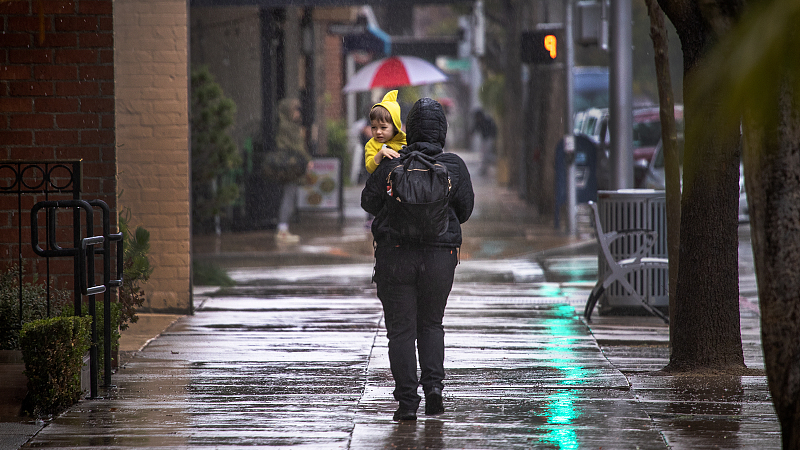
A woman carrying a child walks down the street amidst heavy rain in Pasadena, California, U.S., February 24, 2023. /CFP
A woman carrying a child walks down the street amidst heavy rain in Pasadena, California, U.S., February 24, 2023. /CFP
Editor's note: Bobby Naderi is a London-based journalist, guest contributor in print, radio and television, and documentary filmmaker. The article reflects the author's opinions and not necessarily the views of CGTN.
The U.S. government frequently preaches about human rights in ways that couldn't be more unnerving, calling on the international community to re-examine all conduct and policies, ensuring that children have access to the basic necessities, such as education, healthcare and justice.
Here's the question. Does the U.S. also examine its own human rights record and practices, what it preaches in regards to the children's fundamental rights? It plays out in devastating daily newspaper headlines disclosing that the U.S. government has yet to guide policies, laws and actions to fully-protect American children. Instead, it has shredded the promises and values enshrined by its own constitution.
According to a CGTN poll of global internet users, the U.S. has yet to fully protect children's rights. In the new survey, a staggering 91.2 percent of respondents said they feel "strongly pessimistic" about the current situation of child safety and protection of rights, with 90.8 percent of respondents disappointed with the U.S. government's performance in protecting children's rights.
This eerie "achievement" breaks the UN Convention on the Rights of the Child (UNCRC). Washington has long needed to overhaul its approach to children's rights. More ominously, China's calls on Washington to ratify the UNCRC and take practical actions appear to fall on deaf ears. The U.S. is the only UN member that has not ratified the convention adopted in 1989.
The U.S. remains outside of the treaty due to conservative organizations and federal authorities portraying the UN convention as a threat. Their claims stem from concerns related to national sovereignty, states' rights and the parent-child relationship.
Bureaucratic and cruel
Many juveniles are kept in U.S. prisons alongside criminals and adolescent inmates. None of this is spontaneous, nor is it random. Tens of millions of dollars from the U.S. government have poured into "post-legal" America to ensure that no one would ever think about the unjust enterprise they have built for various far-reaching legal maneuvers.
The U.S. at times has imposed long prison sentences on children. Some sentences imposed on juveniles seem systematic. There's no way to fathom the harm caused by such cruel treatment in the juvenile justice system.
There are many ways to address the wrong. The juvenile justice system fits into America's historical context of racism and social class exclusion and oppression. When kids go astray, the official reaction is to push them away, intensifying their suffering and disenfranchisement.
The juvenile justice system could be called a bureaucratic campaign against young people in for-profit prisons. It remains imperative, however difficult, to give more leeway for subsequent actions in locations where they can obtain the care they require. Nonetheless, putting children in rehabilitation centers might still be a good idea.
Problematic on multiple levels
To rub yet more salt in the wound, the injustices faced by children in the U.S. extend beyond its prisons. Child labor has also increased in the last few years, particularly in low-wage industries, such as agriculture and manufacturing.

A screenshot of a New York Times article about migrant child workers in the U.S. published on February 25, 2023. /The New York Times
A screenshot of a New York Times article about migrant child workers in the U.S. published on February 25, 2023. /The New York Times
There are between 500,000 and 800,000 children currently working in the U.S. with many major U.S. brands and retailers – such as Ford, General Motors, J. Crew and Walmart – involved in these problematic exploitations, according to The New York Times. Despite the Joe Biden administration's promises to end such violations, child labor continues to exist in various forms and on multiple levels.
Children from low-income households are more likely to work to support their families, especially in areas with scarce job opportunities. Although the federal and state laws prohibit the employment of children, enforcement is often weak, since businesses use loopholes and illegal practices to avoid complying with the laws.
The consequences have been devastating nationwide, affecting not only the children involved but also their families and communities. Because of all this and more, many children experience health problems and developmental issues, and receive inadequate education or achieve economic mobility.
The United States' outlandish practices and laws violate universal standards and norms aimed at protecting children through humane and accessible processes. Instead of gaming the international community and breaking hearts and laws, the U.S. government should leave American exceptionalism in the dust, align its juvenile justice system with the UN's recommendations, and ratify the UNCRC. To echo the recent CGTN poll, it would be strange, if not eerie, for official Washington not to live up to its democratic and egalitarian promises.
(If you want to contribute and have specific expertise, please contact us at opinions@cgtn.com. Follow @thouse_opinions on Twitter to discover the latest commentaries in the CGTN Opinion Section.)